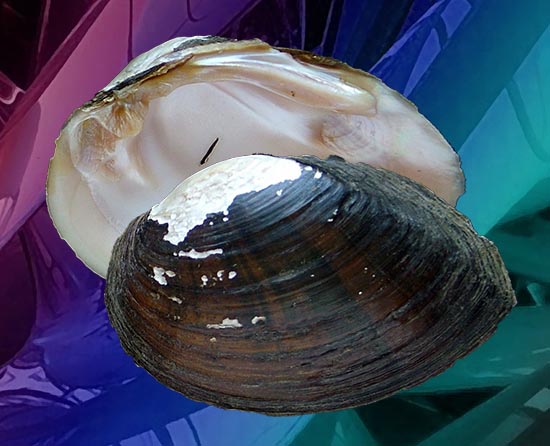| Page last updated
11 December 2017 |
Mussel of the Month
The December 2017 Mussel of the Month is Elliptio crassidens. Elliptio is a genus of 30 species found in eastern North America.

ANSP 20243. River Ohio (Poulson "type" of U nigra).
|
For more than a decade, we have been working our way through the freshwater mussel genera. We thought that we had handled this particular widespread Nearctic genus way back in November 2003 when we shined the spotlight on Elliptio dilatata (the 4th Mussel of the Month ever!). But, the shifting sands of freshwater mussel taxonomy have revealed a new genus-level classification. That species now belongs to the genus Eurynia.
We have had a haboob of genus- and species-level revisions to the MUSSELp Database in recent months. There have been several important publications of late, but the big one for North American mussels is been Williams et al. (2017) — the modern update of Williams et al. (1993) and Turgeon et al. (1998). We will use upcoming Mussel of the Month posts to roll out other such revisions for Europe and Southeast Asia.
E. dilatata was removed from Elliptio because it is never recovered in phylogenetic analyses as a part of the Elliptio clade (Campbell et al., 2005, 2012; Pfeiffer et al., 2016; Perkins et al., 2017). In addition to various generic shuffles, 13 new species of North American mussels were added to our list and 13 more were synonymized away. This momentary confusion is progress! We now report a world-wide total of 906 Recent species of freshwater mussels of the Order Unionoida — exactly one-third of which are found in North America.
These changes have been incorporated into this web site in two places. We have updated the MUSSEL Project Database. The MUSSELpdb is comprehensive and searchable. We have also reviewed, refined, and reformatted the static Unionoida cum Grano Salis pages, which summarize taxonomic and geographical diversity — the frequently updated version of our global checklist (Graf & Cummings, 2007). |
|
Classification:
Phylum Mollusca
Class Bivalvia
Subclass Palaeoheterodonta
Order Unionoida
Family UNIONINDAE Rafinesque, 1820
Subfamily AMBLEMINAE Rafinesque, 1820
Tribe PLEUROBEMINI Hannibal, 1912
Genus Elliptio Rafinesque, 1819
Species Elliptio crassidens (Lamarck, 1819)
(+ E. nigra Rafinesque) |
To find out more about Elliptio crassidens and the classifcation of North American freshwater mussels, check out:
- Graf, D.L. & K.S. Cummings. 2007. Review of the systematics and global diversity of freshwater mussel species (Bivalvia: Unionoida). Journal of Molluscan Studies 73: 291-314.
- Campbell, D.C., J.M. Serb, J.E. Buhay, K.J. Roe, R.L. Minton & C. Lydeard. 2005. Phylogeny of North American amblemines (Bivalvia, Unionidae): prodigious polyphyly proves pervasive across genera. Invertebrate Biology 124(2): 131-164.
- Campbell, D.C. & C. Lydeard. 2012a. Molecular systematics of Fusconaia (Bivalvia: Unionidae: Ambleminae). American Malacological Bulletin 30(1): 1-17.
- Perkins, M.A., N.A. Johnson & M.M. Gangloff. 2017. Molecular systematics of the critically-endangered North American spinymussels (Unionidae: Elliptio and Pleurobema) and description of Parvaspina gen. nov.. Conservation Genetics 18: 745-757.
- Pfeiffer, J.M., N.A. Johnson, C.R. Randklev, R.G. Howells & J.D. Williams. 2016. Generic reclassification and species boundaries in the rediscovered freshwater mussel 'Quadrula' mitchelli (Simpson in Dall, 1896). Conservation Genetics 17(2): 279-292.
- Turgeon, D.D., J.F. Quinn, A.E. Bogan, E.V. Coan, F.G. Hochberg et al. 1998. Common and Scientific Names of Aquatic Invertebrates from the United States and Canada: Mollusks. American Fisheries Society Special Publication (2nd ed.) (26): 526 pp.
- Williams, J.D., M.L. Warren, K.S. Cummings, J.L. Harris & R.J. Neves. 1993. Conservation status of freshwater mussels of the United States and Canada. Fisheries 18(9): 6-22.
- Williams, J.D., A.E. Bogan, R.S. Butler, K.S. Cummings, J.T. Garner et al. 2017. A revised checklist of the freshwater mussels (Mollusca: Bivalvia: Unionida) of the United States and Canada. Freshwater Mollusk Biology and Conservation 20(2): 33-58.
|